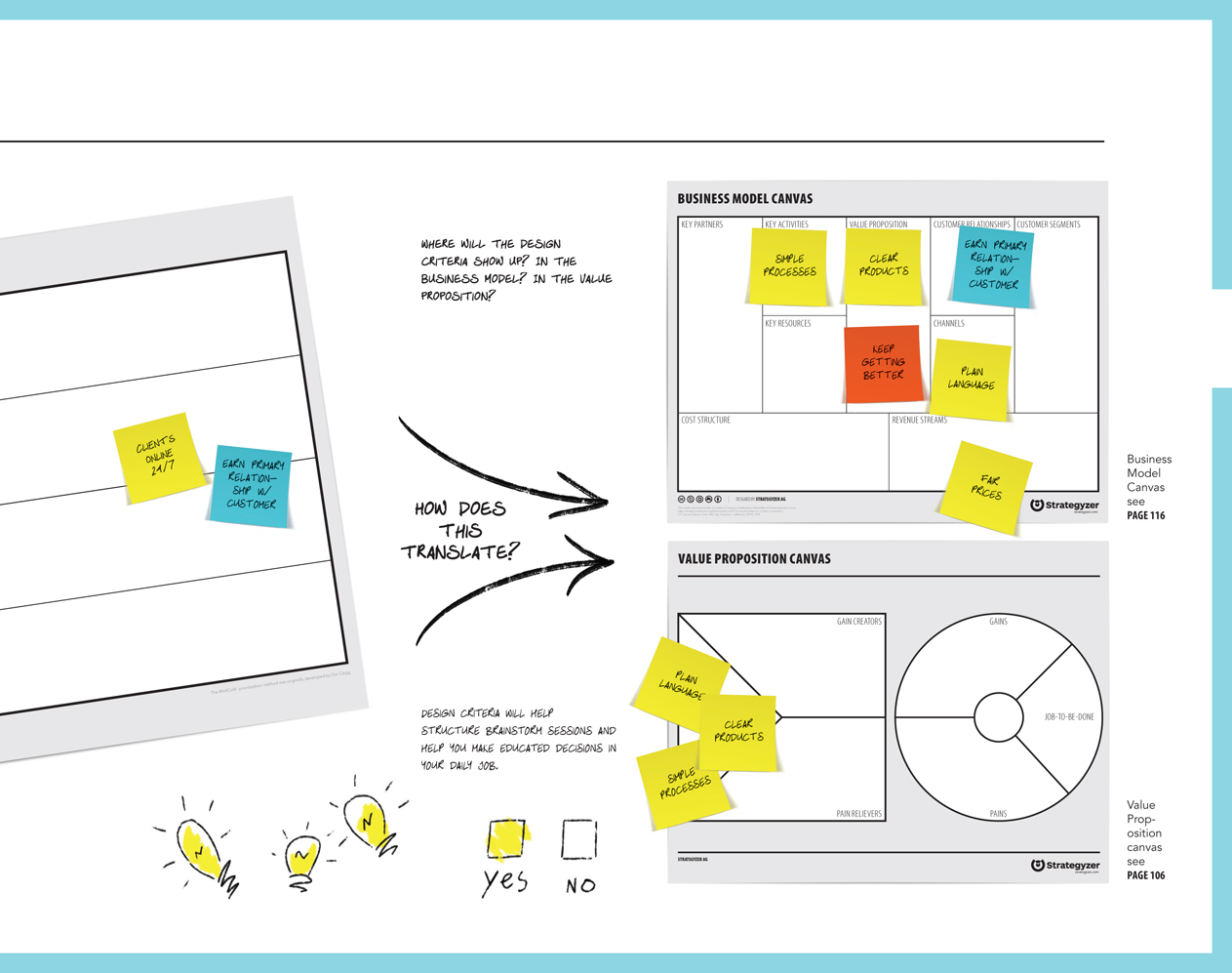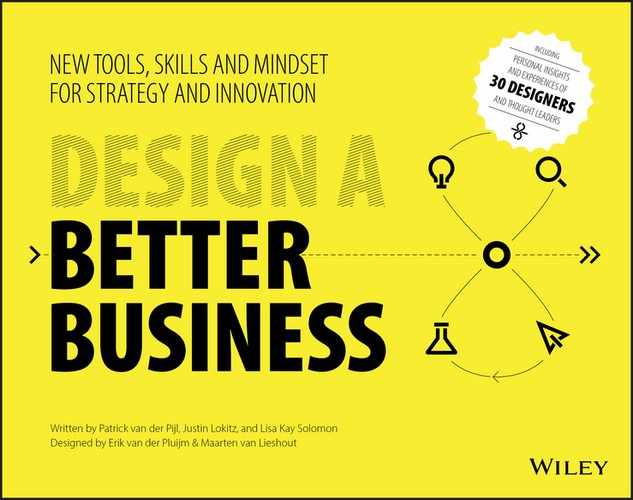Page 68
TOOL DESIGN CRITERIA
Whether you’re designing a new value proposition, business model, or even an entire strategy for the future, design criteria form the principles and benchmarks of the change you’re after. Design criteria are not formulated from thin air. Rather, design criteria incorporate information from your business, vision, customer research, cultural and economic context, and mindset that you have formed along the way.
|
|
|
FOCUS define design criteria |
± 45 MIN session |
3–5 people per group |
WHAT ARE DESIGN CRITERIA?
Don’t think of these criteria as simply features of your idea. They can and should be more than that. For example, a design criteria coming from your vision might be that your business must contribute to a greener planet. Or, maybe you want your customers to feel delighted; this is another design criterion. Does your new business idea need to generate a certain amount of revenue within three years? Chalk that up to more design criteria. In short, design criteria are there to make it easy to determine if you are on the right track.
CREATING THE DESIGN CRITERIA
The design criteria you capture will likely first come from the vision you’ve formulated with your team. You’ll find that some of the elements in that vision are so important that they are nonnegotiable. Yes, that also means that some elements are a bit more flexible (maybe not totally flexible). To find the most important elements in your vision, use the “MoSCoW” method: categorize every element under “Must,” “Should,” “Could,” or “Won’t.” This will help you prioritize.
Now comes the easy part (well, maybe not easy, but doable): sort all of the nonnegotiable elements into the “Must” section of your design criteria and the rest into “Should” (if they are important) or the “Could” sections (if they would be nice to have).
Your vision makes up only part of the story when it comes to defining your design criteria. Other elements could include revenue, or your place in the market, or the impact you’ll have, or the public perception of your company. Once you’ve come up with this list, add these to the “Could,” “Should,” or “Must” sections based on their respective priorities.
Once you’ve started this exercise, you might find that you need to adjust your vision slightly. This may prompt you to take a different direction. If that’s the case, adjust the design criteria so that they match the new direction. As you continue to evolve your point of view, you may need to add or update your design criteria. ![]()

Page 69
DOWNLOAD Download the Design Criteria Canvas from www.designabetterbusiness.com |
CHECKLIST
![]() You have sanitized the design criteria by removing unimportant criteria. Use, e.g., voting.
You have sanitized the design criteria by removing unimportant criteria. Use, e.g., voting.
![]() You have spent time with your team to sharpen and quantify your criteria.
You have spent time with your team to sharpen and quantify your criteria.
![]() You’ve linked up your design criteria with your vision.
You’ve linked up your design criteria with your vision.
NEXT STEPS
![]() Quantify your design criteria: make them S.M.A.R.T. (specific, measurable, achievable, relevant, time-bound).
Quantify your design criteria: make them S.M.A.R.T. (specific, measurable, achievable, relevant, time-bound).
![]() Revisit your design criteria. Do they still make sense?
Revisit your design criteria. Do they still make sense?
Page 70
Page 71
EXAMPLE DESIGN CRITERIA ING BANK


Page 72
INTRO STORYTELLING
As humans, we tell stories every day. We use stories to explain, explore, engage, and persuade others. During the design journey, you will have many moments when you need to tell a good story. And, just like the other fundamentals of your strategy, good stories can be designed.
IT’S HUMAN NATURE
We are all born storytellers. Some of us make a living telling stories. Others have allowed their storytelling skills to be buried by work or school. The medium does not make storytelling nor can it be replaced by slides, emails, or spreadsheets. Though these tools can be used as canvases to tell a good story, you must first design the story you want to tell.
STORY
For as much as we’re all born storytellers, however, not everyone can aspire to be the next Hemingway. But there are tricks to telling great stories! Stories can be designed. And here, we are talking about a broad category of storytelling, from person-to-person chats, to cool TED-style talks, to sales pitches, and even boardroom presentations. These are all stories.
SHARED KNOWLEDGE
Stories are how we have shared knowledge and information since the dawn of humanity. Our brains are shaped by storytelling. Today, stories are still the most powerful way to transfer ideas and beliefs. We live and breathe stories. Perhaps in our daily lives this may be less obvious, but passing knowledge still is a vital skill in our survival toolbox.
ENGAGE
Neurological research shows that the same areas are activated in the brain of a listener as in the brain of the storyteller! Because stories engage emotions and other senses, the listener can “relive” the moment and really learn from it. That is something numbers on a page can never do. In their popular book Made to Stick, Chip and Dan Heath make this point right up front when they recall the popular urban legend (i.e., story) about “the guy” who wakes up in a bathtub filled with ice only to find out that one of his kidneys has been harvested. Remember that one? The reason this engages us is that, as the Heath brothers point out, it’s simple, unexpected, concrete, credible, and emotional.
DEATH BY POWERPOINT
So, if we’re such natural storytellers, why do we still bore each other to death with PowerPoint? It’s because most of us have never really learned how to design stories. Even in school, we were mostly instructed in academic writing and presentation, which is often supposed to be an unemotional, objective, and efficient way of sharing information, rather than engaging.
Page 73
THE STORYTELLING CANVAS
We created the Storytelling Canvas to make it easier to construct a story that people care to listen to. The PowerPoint presentations you give probably lack the emotional depth and impact you want to build in a story. However, the stories we design can be told through the medium of PowerPoint!
Like the other tools in this book, the story canvas allows you to collectively design stories that resonate: by harnessing visual, engaging, insightful, controlled, and inspiring elements. ![]()

| For information on presenting visual stories, read: Resonate by Nancy Duarte |
STORY WITH A BIG S
Story has played a significant role in all cultures but its adoption into professional cultures has been painfully slow. That’s because it’s easier to give a cut-and-dried report than a well-crafted presentation that incorporates stories.
I know “story” has become a buzzword, but that’s just story with a little “s.” What I’m talking about is story with a big “S”: the art of communicating your ideas using a persuasive narrative structure. It’s a story that has a beginning, middle, and end, and uses dramatic principles of tension and contrast to move your audience to a different state of thinking, feeling, and acting.

Nancy Duarte
Author, Principal at Duarte, Inc.

